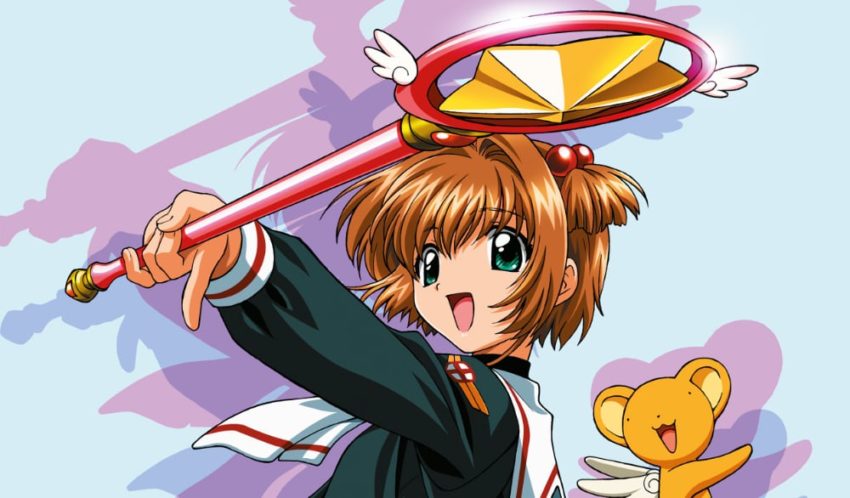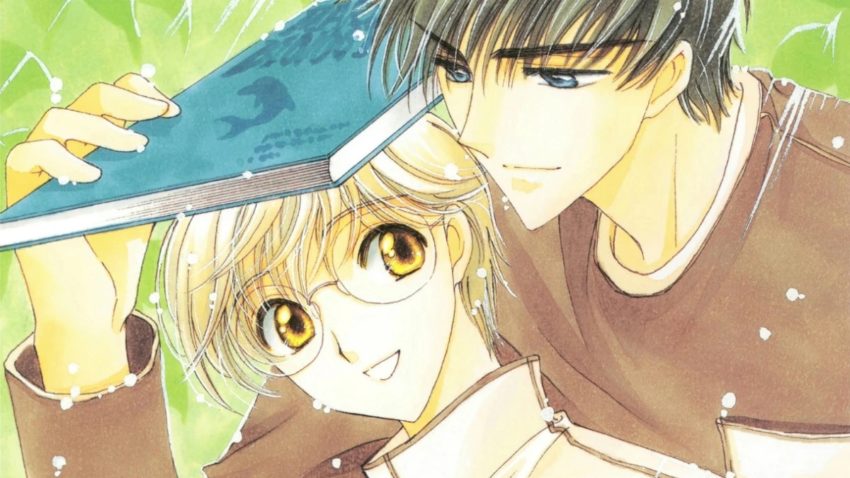Cardcaptor Sakura
December 3, 2021 · 0 comments
By Andrew Osmond.

Cardcaptor Sakura shows how the biggest, most wonderful adventure can start from the smallest of things. In the show’s first episode, Sakura Kinomoto, a happy, lively grade school girl, returns from school to find she’s the first home. She hears a funny rustling sound coming from her dad’s basement study. Worried it might be a burglar, Sakura creeps downstairs into the book-lined room, her majorette’s baton raised at the ready. No-one is around, but there’s something even stranger – one of the books on the shelves is glowing. She takes the book out; it’s a thick red tome sealed by a metal clasp, with the title The Clow.
As Sakura holds the book, its seal glows and pops open, giving her a fright. She opens the cover and finds something lying on the first page – a card, bearing the image of a sleeping nymph with the name “The Windy.” Suddenly the card itself glows and Sakura finds herself standing on a brilliant magic circle! A mighty wind blows up, ruffling the pages of The Clow book. From its pages, dozens of cards blow into the air, flying upward in birdlike spirals, vanishing through the ceiling and zooming into the sky over Sakura’s house in flashes of light.
So Sakura’s story begins…
Cardcaptor Sakura itself might seem a small thing; just a cute kids’ cartoon about a girl’s magic adventures. But for hordes of viewers around the world, it meant much more. Some first encountered it as a kids’ cartoon, simple-seeming at first; but as the weeks passed, those viewers became more and more invested in the show’s characters, their friendships and crushes, and the suggestion of feelings that weren’t just child’s play.

Older fans came to Cardcaptor because they already knew its creators. Cardcaptor came from a team of female manga artists called CLAMP, whose work mostly wasn’t kids’ stuff. But CLAMP wasn’t making Cardcaptor just for hire, but as a new vehicle for their visions and ideas, seen through a child’s eyes but not dumbed down in the least. At least it wasn’t dumbed down in Japan, though it was infamously travestied when the series first arrived in America. But even in the American version, some kids saw through the censorship to CLAMP’s vision.
Cardcaptor’s real story starts with the CLAMP artists, but it also begins with a manga magazine for young girls. The magazine is Nakayoshi, first published in 1954, making it fourteen years older than Shonen Jump (it’s still running now). Its target readership is girls aged 8 to 14, and its early strips included some episodes of Osamu Tezuka’s Princess Knight, whose hero had the spirits of both a boy and girl. Even in the 1950s, girls’ manga played with supposed gender rules.
A more direct forerunner to Cardcaptor was Sailor Moon. The original manga by Naoko Takeuchi was serialised in Nakayoshi from 1991. For anyone who doesn’t know, Sailor Moon is about a girl – a high-schooler, unlike the preteen Sakura – who gains magic powers and fights evil with a growing circle of allies, mostly girls like herself. From 1992, Sailor Moon was turned into an animated series by the Toei studio, beginning a franchise.

Sailor Moon was a huge hit for Nakayoshi. The magazine’s circulation doubled, while the anime version scored a 12% audience share in its primetime Saturday evening slot. Although the series was made to obvious formulas, the Anime Encyclopaedia commented, “the show is saved from banality by the strength of its plotting, its earnest, honest romance and its refusal to talk down to its audience.” It could look adorably cute, then plunge into full-on tragic drama, as anyone who saw the end of the first TV season could tell you. Naturally Nakayoshi wanted creators who could serve up more of that calibre, and looked to CLAMP.
Like Gainax’s founders in the 1980s, or Makoto Shinkai in the 2000s, CLAMP represented the fan dream; the enthusiastic amateurs going pro. CLAMP originated as a circle of young manga artists, all women, who met in the neighbouring cities of Osaka and Kobe in the mid-1980s. At first, they produced dojinshi, amateur comics, including unauthorised versions of such strips as Captain Tsubasa.
In 2007, a Wired journalist interviewed CLAMP’s now-famous leader Nanase Ohkawa. During the interview, the interviewer presented her with dojinshi based on CLAMP’s own strips, including a “remixed” version of Cardcaptor. Ohkawa’s response was to burst out laughing and flip through them eagerly, praising their creativity.
By the time CLAMP starting making professional manga in 1989, some of its members had already dropped out. More left in the next few years, leaving four. This quartet included Ohkawa, the “producer-director” of the team, responsible for the scripts and plots. “I decide who does the characters, and what she’s going to do with them, as a director would pick his actors,” Ohkawa explained. Her fellow artists were Mokona (the pen name for Mokono Apapa), Tsubasa Nekoi and Satsuki Igarashi.

CLAMP’s first pro strip was the mythological fantasy RG Veda. The group’s other early manga included the horror series Tokyo Babylon; the lighter-hearted CLAMP School Detectives; and the sexy, lesbian-themed fantasy Miyuki-chan in Wonderland. All became anime, though at first they were condensed into video productions for the fans.
While CLAMP’s early work was far from Nakayoshi territory, it’s obvious why the group’s energy, invention and range of genre would attract the magazine. For her part, Ohkawa said, CLAMP had a mercenary motive for creating something for younger readers. CLAMP’s established fans were already growing older. A Nakayoshi manga could be just the thing for the group to hook new followers!
From 1993, a CLAMP strip debuted in Nakayoshi, but it wasn’t Cardcaptor. It was Magic Knight Rayearth, about three girl high schoolers drawn into a fantasy world; they also learn to pilot robots. From 1994, Rayearth was adapted as a TV anime, the first TV version of a CLAMP strip. (CLAMP School Detectives predated Rayearth as a manga, but the anime wasn’t made until 1997.)
Now available from Anime Limited, the Rayearth anime ran for a year (49 episodes). As well as its success in Japan, it was an export hit in the Philippines, a territory which would embrace Cardcaptor with similar enthusiasm. This was when Sailor Moon was still struggling to find an audience in America.
The Sailor Moon manga was still running in Nakayoshi in 1996 when CLAMP finished the Rayearth manga. But before then, CLAMP’s artists had already been asked by Nakayoshi’s editor about doing a replacement strip. Ohkawa commented that with Rayearth, CLAMP had aimed to create a “completely different” kind of Nakayoshi manga. In contrast, Cardcaptor was conceived as traditionally Nakayoshi-esque. Ohkawa recalled that CLAMP had needed to explain the complications of some of their earlier stories to puzzled editors. With Cardcaptor, they wanted to make something easily understood, and cute to boot.

Many of Cardcaptor’s basic elements – as opposed to the elaborate relationships that emerge later – are standard “magic girl” fare. The genre, based on girls with magical powers, had been a staple in Japanese comics and cartoons since the 1960s. While the hit Sailor Moon featured teens, Cardcaptor kept to the mould of older stories with its preteen heroine, like the 1960s Little Witch Sally and the 1980s Minky Momo. Cardcaptor had established magic girl trappings, such as its heroine’s bright costumes, her “wand” (actually staff) and her cute talking animal familiar.
Ohkawa admitted she didn’t know the genre well; as a child, she’d preferred detective stories. However, she understood the appeal of magic girls, creating the cheery, well-adjusted Sakura as an identification figure for girls of a similar age. Like many other magic girls, Sakura is essentially ordinary despite her powers. Her magic doesn’t let her off mundane things like studying hard or doing chores at home. Ohkawa pointed out that Sakura is the least CLAMP-ish character in the story, though she’s surrounded by characters more in the CLAMP mould.
Sakura’s family consists of her father Fujitaka, a kindly archaeology professor, and her teen big brother Touya – her mother is deceased. Sakura and Touya have an adversarial relationship, with Touya teasing and infuriating Sakura something rotten, and Sakura aiming kicks at his shins. However, Sakura has a massive crush on her brother’s best friend, a boy his age called Yukito. Yukito is an ideal type in girls’ comics. A boy in glasses, he’s feminine, gentle, sensitive and as affectionate towards Sakura as Touya is mean. Yukito is voiced in Japanese by actress Megumi Ogata, best known as Shinji in Evangelion. Ogata’s earlier roles included a lesbian magic girl, Sailor Uranus in Sailor Moon.
As for female friends, Sakura is pretty much inseparable from her grade school classmate Tomoyo. There’ll be much more to say about her in the second part of this article. Tomoyo is voiced by Junko Iwao, who came onto the Cardcaptor anime from an adult Madhouse title; she was the tormented singer Mima in Satoshi Kon’s Perfect Blue.

A magic girl needs a magic talking animal, and for Sakura it’s Cerberus. Students of Greek myth will know he’s named for a fearsome monster, which seems comically inappropriate, given he looks like an adorable yellow teddy. He has wings, a fluffy tail and an Osaka accent, reflecting one of CLAMP’s home cities. Pretty much everyone mistakes him for a plush toy, which offends his dignity but lets him go about the human world unnoticed. He’s voiced, at least most of the time, by actress Aya Hisakawa, another Sailor Moon alumnus; she voiced Sailor Mercury. Kero has another voice and form later, but spoilers.
Cerberus – soon nicknamed Kero or Kero-chan – first appears in the scene described at the start, after the cards escape the Clow book in Sakura’s basement. He emerges from the book’s cover, greets Sakura cheerily, and is devastated to find the cards gone (except for “The Windy”, which caused all the trouble). The cards, Kero explains forlornly, are Clow cards, created by a fabled sorcerer called Clow Reed. Each card is a living being, with incredible powers. However, they’re capricious and mischievous, and some are dangerous. Kero was the “Beast of the Seal,” placed in the book to guard the cards, but he, ahem, fall asleep on the job.
Now, Kero insists, Sakura must retrieve the lost Clow Cards. Otherwise a catastrophe will befall the world. Kero also claims Sakura must have magic herself, in order for her to have opened the book at all. As it happens, Sakura previously had a strange dream, in which she wore an elaborate costume and carried a staff, with one end shaped like a bird’s head. Now Kero presents her with an identical staff and dubs her a Cardcaptor, with the task of finding and “sealing” each of the cards, using the cards already in her possession. Okay, so she only has one card to start with…
It looks like a simple “catch ’em all” fetch quest. Inevitably some commentators would compare the premise to Pokémon, though when the Cardcaptor manga debuted in May 1996, the first Pokémon games were only months old. Ohkawa herself said at first Sakura was going to be a good witch, like some earlier magical girls. However, the artists wanted the character to be more than that, hence the Cardcaptor concept. As for the card motif, it came from Tarot cards.
But Cardcaptor Sakura was about far more than collecting cards, although that is a story for another day…
Andrew Osmond is the author of 100 Animated Feature Films. Cardcaptor Sakura is released in English by Anime Limited.
Leave a Reply